Komondor Breed Information: Facts, Traits, Pictures & More
When you purchase through links on our site, we may earn a commission. Here’s how it works.
The Komondor, also known as the Hungarian Sheepdog, is one of the most distinctive-looking dogs on the planet, thanks to their long, white doggy dreadlocks. But there’s more to this pup than their dreads. They are powerful and protective Hungarian flock guardians. They are also super sweet, affectionate, and loving with their families, earning them a top spot as a family-friendly canine companion.
Table of Contents
The Komondor isn’t the best choice for families looking for a laidback, low-maintenance pet. This pooch is stubborn and independent, which makes them challenging to train. They are highly protective, too, so they need a strong caregiver who can take charge. Not all Koms like other dogs, making this breed unsuitable for a multi-dog household. But for the right family, they offer utmost loyalty and lots of fun, and they are proper doggy dogs.
In this Komondor breed guide, we look at their history and how this affects their personality, as well as their coat and how to look after it. You don’t need a brush, just lots of towels, a floor fan, and plenty of patience. Plus, we explore their needs, health, and, most importantly, what type of family and home they seek.
History
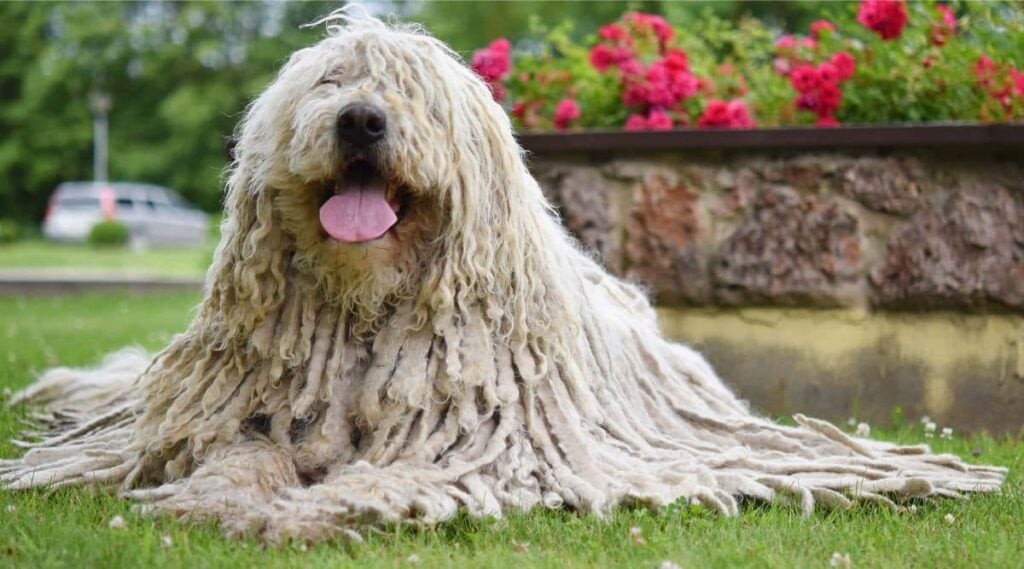
Although this pup is linked to Hungary, they originate from China, east of the Yellow River, and descend from Tibetan dogs. Komondor translates to “dog of the Cumans,” it was first recorded in writing in the mid-1500s. Cumans were experts at keeping livestock with their dogs, so much so that other tribes captured them to train their horses and dogs and manage their livestock.
These livestock experts needed a large, sturdy, robust canine to protect their animals from predators. They also needed a dog with a protective coat that could blend seamlessly into the herd of sheep and protect them from predators. As a result, they developed the ancestor of the Komondor we know and love today, and they are commonly called the Hungarian Sheepdog. The Cumans relied on their dogs so much that they considered them sacred.
Despite many societal changes since the Cuman era, what has not changed is the Komondor. The American Kennel Club (AKC) officially recognized them in 1937. They are rare dogs in America, but their popularity has risen recently. There are three Hungarian sheepdog types, the Kom, the Puli, and the Pumi. The Puli is the oldest Hungarian Sheepdog breed, and they look a lot like the Komondor but about a third of the size.
Temperament
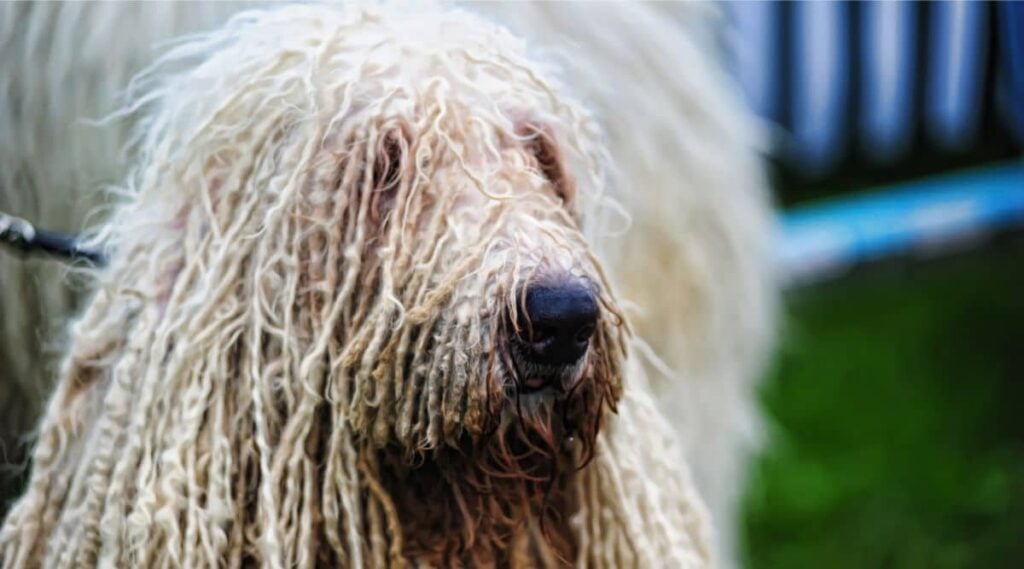
You can expect them to treat you and your family with the same protectiveness. They are very affectionate with their loved ones, and despite their size, they’re always looking to hop onto the sofa with you for a snuggle. They are playful and comical at home with their family behind closed doors, which is a side most people don’t get to see out in public.
Koms are aloof with strangers, keeping an eye on them at a distance, ensuring their humans are always safe. They have a loud bark showing off their watchdog abilities. Although Koms don’t go looking for a fight, they’ll protect their home and family with their life if they need to. They are courageous in the face of predators like wolves and coyotes, which can be helpful in certain areas. They are loyal to their families and don’t stray far.
Komondors aren’t particularly social with other dogs, so they aren’t a wise choice for families looking to add another canine to their family later. It also means you need to be wary when walking around in public because they might take a sudden dislike to a dog at any moment. With proper and consistent training, Koms are generally polite dogs but don’t expect them to be super social at the doggy park.
Size & Appearance
The Komondor is a large to giant dog breed. Females usually measure 25.5 inches and upwards and weigh 80 pounds or more. Males can be much larger, measuring 27.5 inches or more. They typically weigh over 100 pounds, with a heavy bone structure and lots of muscle. Koms have large heads, and through their coat, you can barely see their medium-sized almond-shaped eyes and cheeky smile.
If you want to show your Kom in the show ring, they should be as close to the Komondor breed standard guidelines as possible. Here you can find the guidelines regarding their appearance and what is preferred, faulted, or disqualified. These rules aren’t important if you’re looking for a family companion. Instead, a well-rounded and loyal personality is more important.
Coat & Colors

A puppy coat is quite soft, dense, and wooly. Their coat clumps at the base between 8 and 12 months of age, called “plating up.” These clumps are caused by the long, coarse, wavy hairs that gradually tighten around the softer undercoat, turning into cords.
The cords grow slowly and, over the years, acquire the swing and length of an adult coat. The cords are heavy and felt-like. Koms whose coat does not naturally cord by two years of age are disqualified from the conformation ring. Straight and silky coats exist in the breed but are rare and a fault. A Kom’s coat is always white, although it often appears off-white, or at least not brilliant white like brushed dogs do.
Exercise & Living Conditions
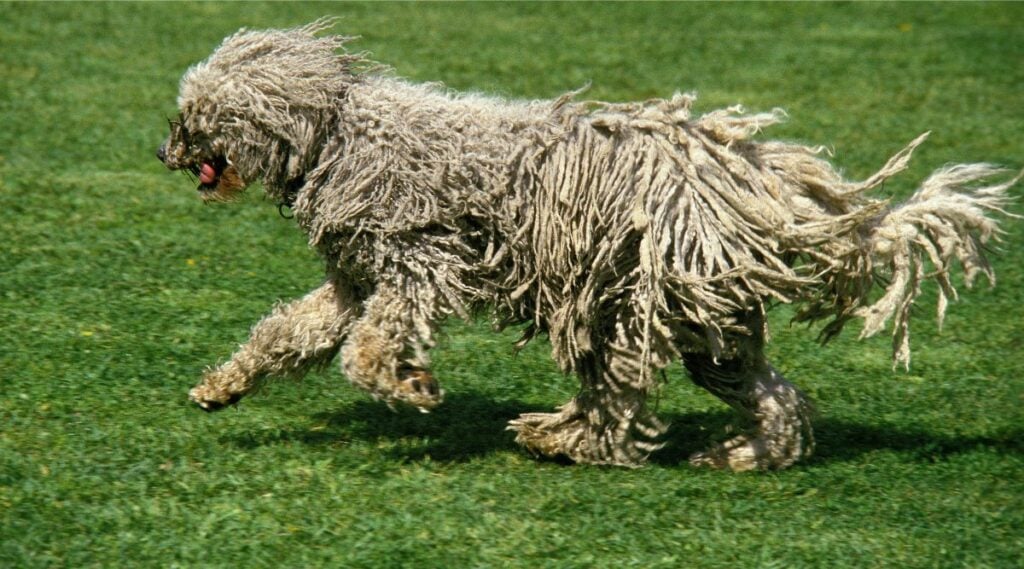
The Komondor is a moderately active dog who only needs a few short daily walks. Because they are highly protective, they get most of their steps following you around the house. Their intense brain needs stimulation throughout the day through interactive playtime and puzzling dog toys. Otherwise, they might become restless and become destructive doggos.
Seeing a Komondor in action is impressive. They have the powerful body of a Mastiff-type dog but are light on their feet and agile, like a Border Collie. Please remember that their large size and fast pace can be alarming for people who don’t know this breed well. For this reason, and because of their highly protective nature and caution towards dogs, you should keep this pup on a leash in public.
Although an apartment or condo might not be high up on their forever home list, they could survive in a smaller space as long as they received enough exercise. But their large size and swaying cords make them better suited to larger living environments. Regardless of their living room, ensuring the home and yard are secure is non-negotiable. If an animal strays into their space, they chase them with tunnel vision, straight into traffic, for example. So for your Kom’s safety and the other animal’s, keeping them fenced in is crucial.
Koms can live with dog-savvy children, but you should always supervise them. They are playful and don’t realize how big they are, which can lead to injuries. But if you think your kids are ready for a large dog, they won’t find a better friend than in the protective Komondor. Like many guard dogs, they are drawn to younger family members. Regarding other animals, Koms aren’t the best match for multi-dog households. In fact, they are better suited to living with a cat than a dog.
Training
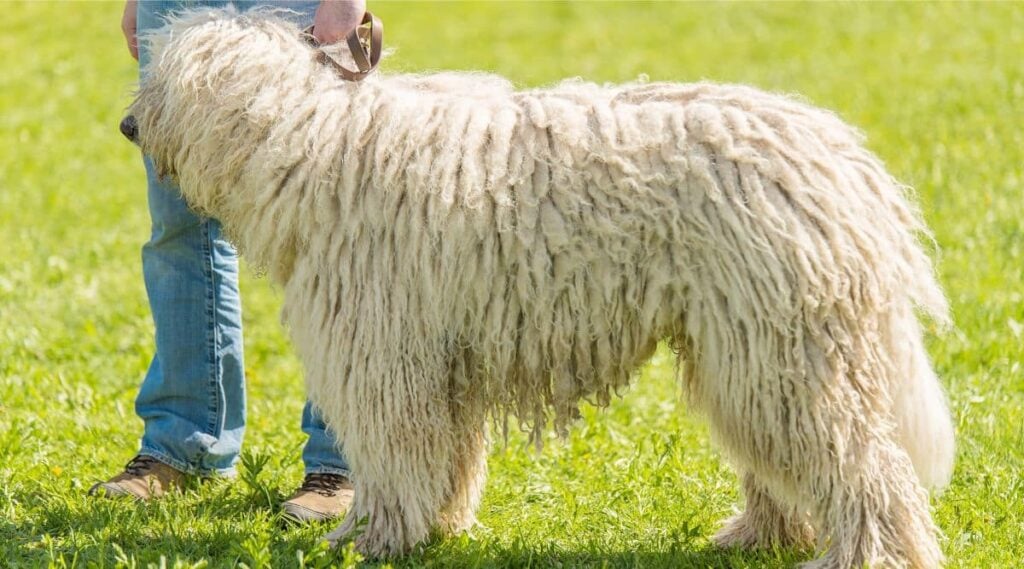
They are capable, but they know it. Koms are stubborn and very independent dogs that require an experienced dog owner to get the best out of them. They are sensitive, so they need a balance of kind but firm leadership. First-time dog owners should stay away from this breed.
Owners should begin training as soon as possible to develop into well-rounded and gentle adults. Koms are very independent and must start obedience training when you bring them home. You need to establish your position as a leader from day one. You must also train your Kom to walk well on a leash, too, because their power and speed can easily pull over their owner.
Early socialization is crucial to prevent their protective nature from becoming overly cautious or aggressive. Ensuring your pup is mixed with as many other pups as possible can limit future fear and aggression toward other dogs. But you must be aware that some Koms aren’t comfortable around other dogs, no matter how hard you try. Koms don’t fully mature until they are around three, so expect puppy-like behavior for a while. Remember that their protective nature might not fully reveal itself until then.
Health
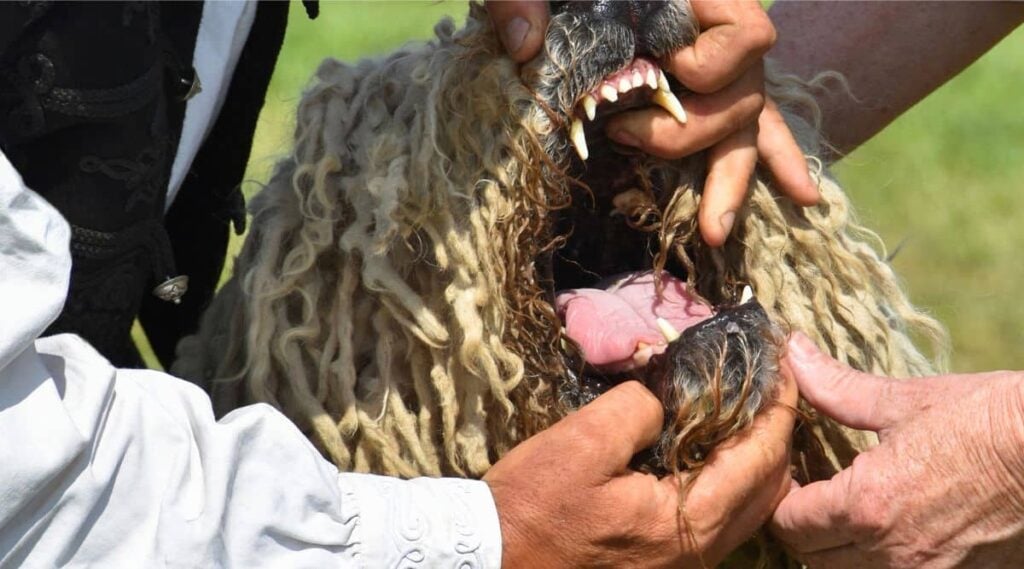
Komondors are relatively healthy dog breeds with a life expectancy of 10 to 12 years, a reasonable lifespan for a giant dog breed. Visiting your vet regularly is an integral part of keeping them healthy. Although your Kom might not experience any of these conditions, it’s essential to be aware of them.
Degenerative Myelopathy
Degenerative myelopathy (DM) is a disease that affects the spinal cord, and it causes progressive muscle weakness and loss of coordination. It usually affects dogs aged eight and over, beginning in the rear limbs. Look for symptoms such as difficulty rising, limb weakness, muscle loss, and incoordination. Breeders are highly recommended to submit their dogs to a DNA test, and any dog with a positive result should not breed.
Eye Conditions
Koms are at risk of several inherited diseases of the eye. The most common include entropion and cataracts. Entropion occurs when the eyelid rolls inwards and the eyelashes damage the eye. Early diagnosis can prevent severe issues, including blindness. Responsible breeders must ensure that their dogs undergo an ophthalmologist test yearly and that the results are registered with the Orthopedic Foundation for Animals (OFA) or the Canine Eye Registration Foundation (CERF.)
Gastric Dilatation Volvulus
Gastric dilatation volvulus (GDV) is more commonly known as bloat. It is a life-threatening condition that requires immediate medical attention and can result in death very quickly. It usually happens after consuming a large meal close to an exercise session, although this isn’t always the case. The stomach dilates and expands, restricting blood flow, rupturing the stomach wall, and leading to shock, which causes other organs to shut down. Make yourself aware of the symptoms and act immediately.
Hip & Elbow Dysplasia
Hip and elbow dysplasia are developmental orthopedic conditions that result in abnormally formed joints. It is a genetic disease affected by several factors, such as diet, exercise, growth rate, and environment. Although not life-threatening, it can cause severe pain and mobility issues in later life. Treatment can include medication or surgery, depending on the dog’s clinical signs and discomfort.
Nutrition
Komondors don’t eat as much as similarly-sized dogs, which helps to keep the monthly food bill down. In their traditional roles as flock guardians, they shared what the shepherd was eating, or they had to fend for themselves. The Komondor Club of America state that most adult Koms eat no more than three cups of food a day. Although all Koms are different, generic feeding guidelines are often too generous, so discuss this with your breeder or vet.
What you feed your Kom depends on many factors, such as lifestyle, preference, and budget. Regardless of the diet you pick, it needs to be a high-quality diet that meets the standards set by the Association of American Feed Control Officials (AAFCO). Choose a diet with high-quality animal-based protein, healthy fats, vitamins, and minerals. Why not consider a convenient and fresh subscription service such as Nom Nom?
Grooming
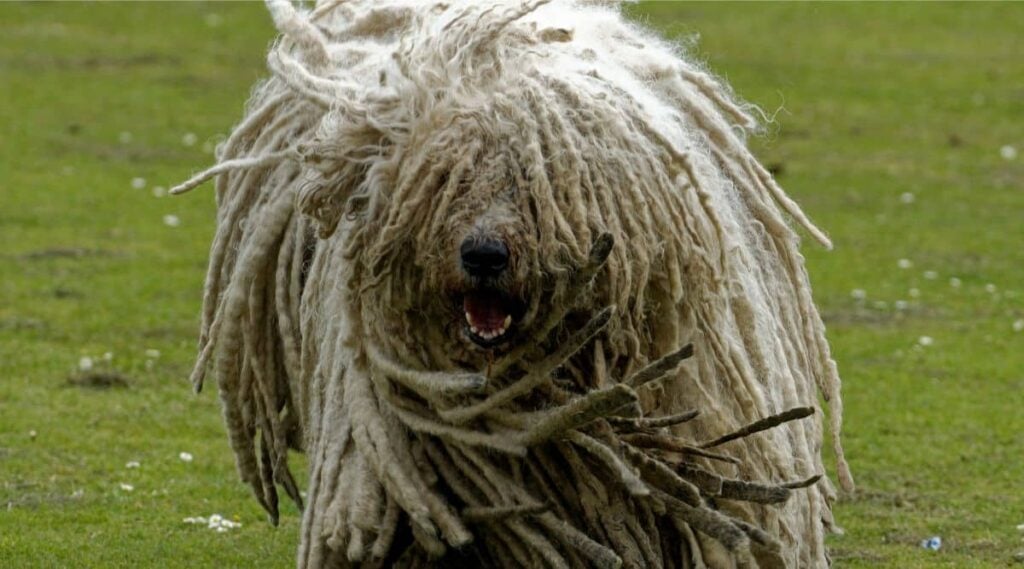
But you need plenty of time and patience. Between 8 and 12 months, you must help separate the clumps according to the curls’ natural separation points and patterns. The base of the cords should be the size of a quarter. In the process of wetting and drying the cords, along with time, the clumps tighten and turn into cords. You must dedicate some time every week to inspect and keep their cords neat.
There are a few tricks to maintain a healthy Kom coat. The first is never to allow it to get too dirty, and be sure to rinse them as soon as you notice any dirt with a garden hose. The second is to rinse them with a dilute shampoo and squeeze the water out with a towel. The shampoo helps to tease out dirt and oil, and towel drying helps to keep the cords neat and compact. The third is to ensure that their cords are dried properly because damp hair attracts dirt easier and can mildew, leading to sore spots and infection. A dryer or floor fan is a valuable tool to ensure dryness, and they love to laze in front of them with their legs in the air.
Komondors are prone to dental diseases and tooth loss, so it’s crucial to establish a dental routine from a young age. Brush their teeth several times a week with doggy toothpaste. Their nails need trimming when they get too long and inspect their ears weekly for dirt, debris, and signs of infection. Make grooming and handling a positive experience for them at a young age because it makes grooming and veterinary visits much easier when they reach their full size.
Breeders & Puppy Costs
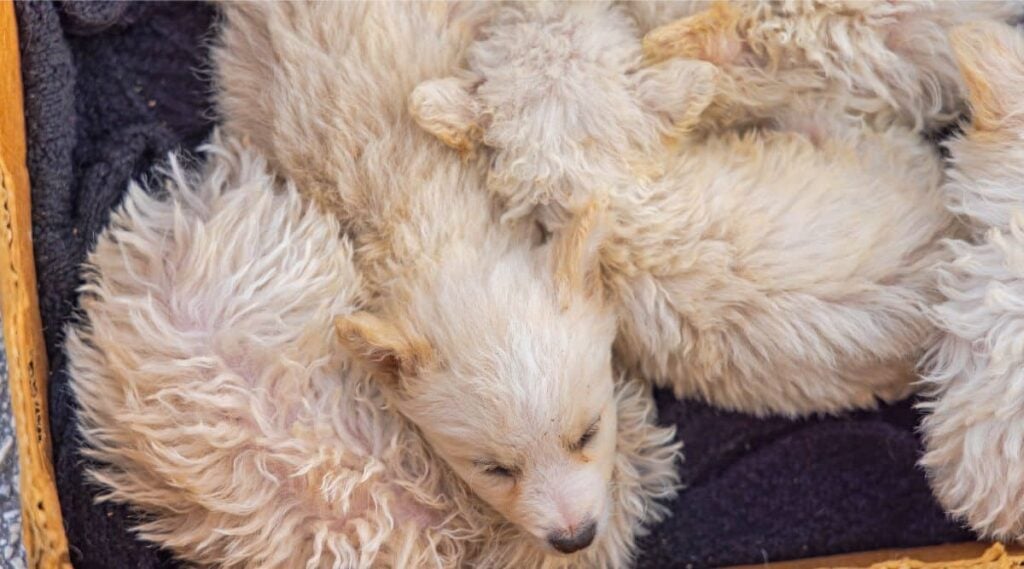
Komondors are rare in America, which means responsible breeders are too, but it’s imperative to find one if you want a healthy and happy puppy. A great place to start your breeder search is on the AKC’s Komondor breeder page. Watch out for irresponsible breeders who do not screen their dogs for hereditary diseases or puppy mills who have no interest in the health of their litters.
The average price of a Komondor puppy falls anywhere between $1,200 and $2,000. If you are looking for a Kom from an award-winning bloodline or champion bloodline, you can expect to pay more than this. This is just the initial cost of the puppy, but puppies need a lot of equipment and items to settle into their new home.
Rescues & Shelters
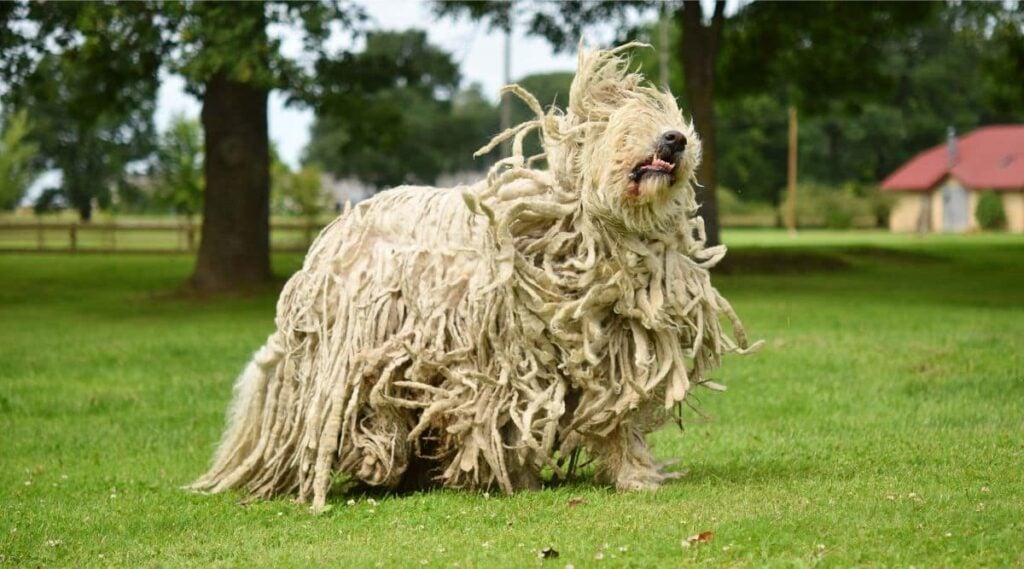
Finding a Komondor in a rescue shelter is rare, and they are likely to be adopted quickly because of it. Plus, many breeders stipulate in their puppy contracts that unwanted dogs must be returned to them. Alternatively, contact the Komondor Club of America’s rescue coordinator, or search online rescue organizations.
As A Family Pet
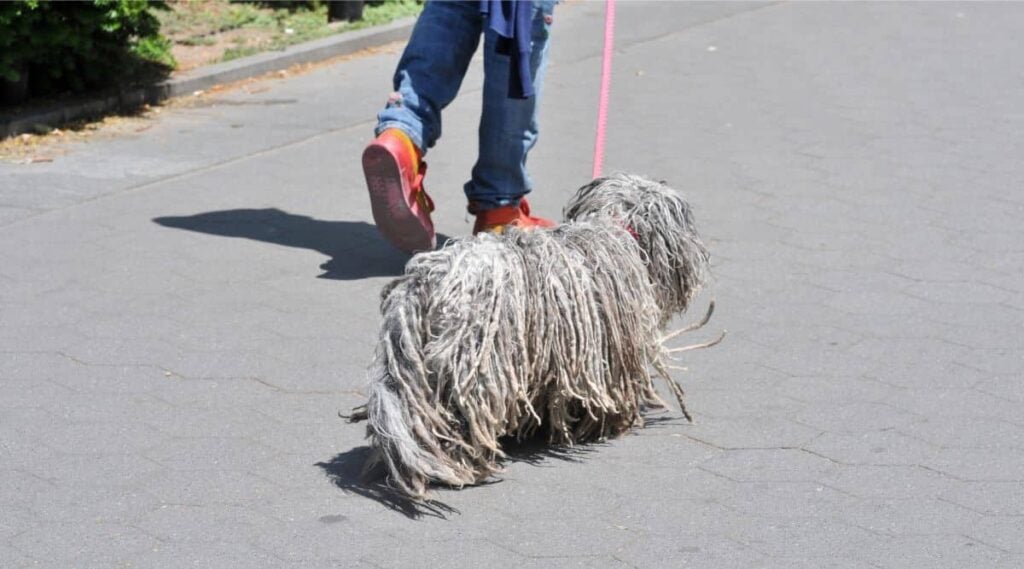
- The Komondor is a powerful and protective dog, and they protect their home and family with their life.
- They are brilliant watchdogs and have a loud and persistent bark.
- Koms are fun and playful with their family.
- Most Koms are wary of other dogs, so you need to be alert to other canines around you in public.
- Their protective nature makes them super fond of children, sticking close to them.
- Koms are aloof with strangers, and you must introduce them to visitors.
- They only need around 30 minutes of outdoor exercise daily, but lots of mental stimulation and play.
- The Komondor is a large bordering on giant dog breed, so you need space.
- Their corded coat is high-maintenance.
- They have a highly independent and stubborn personality, so training is challenging and a lifelong commitment.
Final Thoughts
They are traditional flock guardians, so you can be sure they’ll protect your family and home with everything they’ve got. Thankfully they are also sweet and affectionate pups that make a great family pet. But as you can see, they are high-maintenance dogs with an intensely independent personality, so they aren’t suitable for the average family home. But if you can offer them what they need, you won’t find a better family companion than this dreadlock doggy dude.



